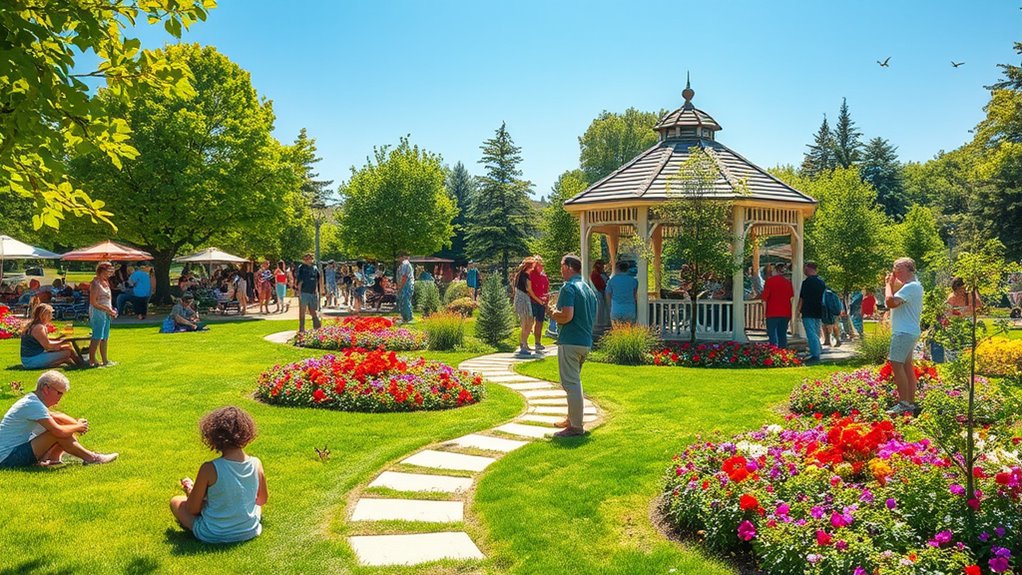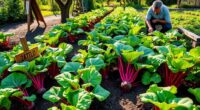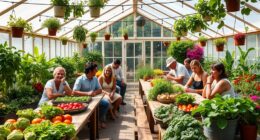If you're looking for the best ways to celebrate National Public Gardens Day, I've got some amazing ideas for you! From guided tours and children's activities to special plant sales, there's something for everyone. Engage with local gardens through community events that highlight seasonal blooms and sustainable practices. You can even participate in workshops to enhance your gardening skills. Stick around to discover even more ways to connect with nature and your community!
Key Takeaways
- Attend guided tours at local gardens to learn about seasonal blooms and sustainable practices while enjoying nature's beauty.
- Participate in family-friendly activities and children's programs designed to inspire a love for gardening and environmental stewardship.
- Explore plant sales featuring native plants and gardening supplies to enhance your home garden and support local biodiversity.
- Engage in themed displays and exhibitions that showcase the diversity of plants and promote community well-being on National Public Gardens Day.
- Volunteer for conservation efforts that protect endangered plant species and restore habitats, fostering a deeper connection to the local environment.
National Audubon Society Wildflowers of North America Guide
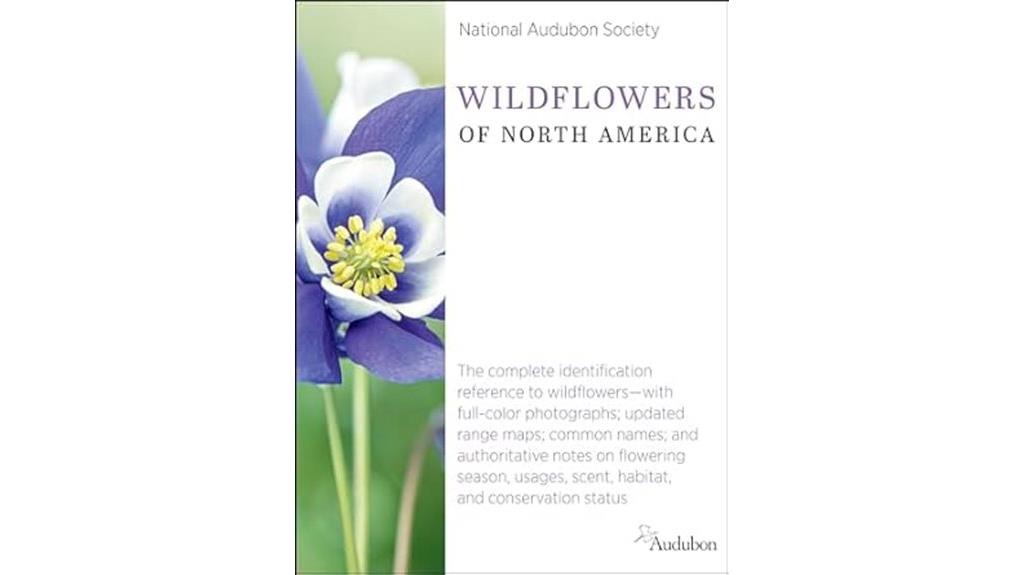
If you're someone who loves exploring the great outdoors and wants to identify wildflowers during your hikes, the National Audubon Society Wildflowers of North America Guide is perfect for you. This guide has breathtaking illustrations and a logical layout that makes finding the right flower enjoyable. I remember a friend who regretted not buying it at a botanical garden but later found it on Amazon. The added maps showing plant ranges are super helpful too. While it might be tricky for beginners, the visuals make it easier to learn. Overall, it's a fantastic resource for any nature enthusiast!
Best For: Nature enthusiasts and hikers looking for a comprehensive guide to identify wildflowers during their outdoor adventures.
Pros:
- Beautiful illustrations and logical arrangement make plant identification enjoyable and straightforward.
- Includes maps that show the natural range of plants, aiding users in finding native species for wildlife gardens.
- Flex binding and large format provide a user-friendly experience with numerous images for reference.
Cons:
- May be challenging for beginners unfamiliar with plant names or families, making identification difficult.
- Some wildflowers, such as Palmers Penstamon and Clelands Evening Primrose, are missing from the guide.
- Lacks a good botanical key, which might limit identification for some users.
The Southerners Handbook: A Guide to Living the Good Life
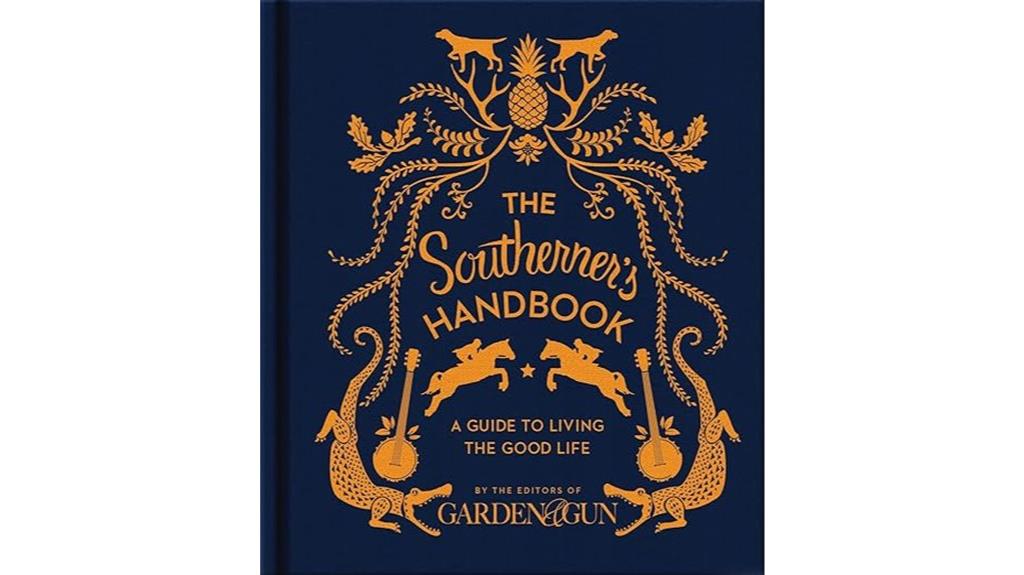
For anyone looking to immerse themselves in the charm and traditions of Southern living, "The Southerners Handbook: A Guide to Living the Good Life" stands out as an essential resource. This book captivates with its insights on Southern culture, from hunting and cooking to party planning. I found it engaging and entertaining, perfect for quick reads or deeper dives. Its aesthetic appeal makes it an eye-catching addition to any coffee table, sparking conversations among guests. Plus, it makes for a thoughtful gift for family members who appreciate Southern traditions. Despite some production quality concerns, the content shines brightly.
Best For: Anyone interested in embracing Southern culture and traditions, from newcomers to lifelong enthusiasts.
Pros:
- Engaging and entertaining writing style makes it suitable for both casual reading and in-depth exploration.
- Visually appealing design complements home decor and encourages conversations among guests.
- A thoughtful gift option for family members who appreciate Southern traditions and lifestyle.
Cons:
- Some readers find the production quality lacking compared to expectations set by similar publications like Garden and Gun.
- Minimal illustrations and photography may not satisfy all readers' desires for a more luxurious presentation.
- The book's content may not appeal to those unfamiliar or uninterested in Southern culture.
Barefoot Contessa at Home Cookbook
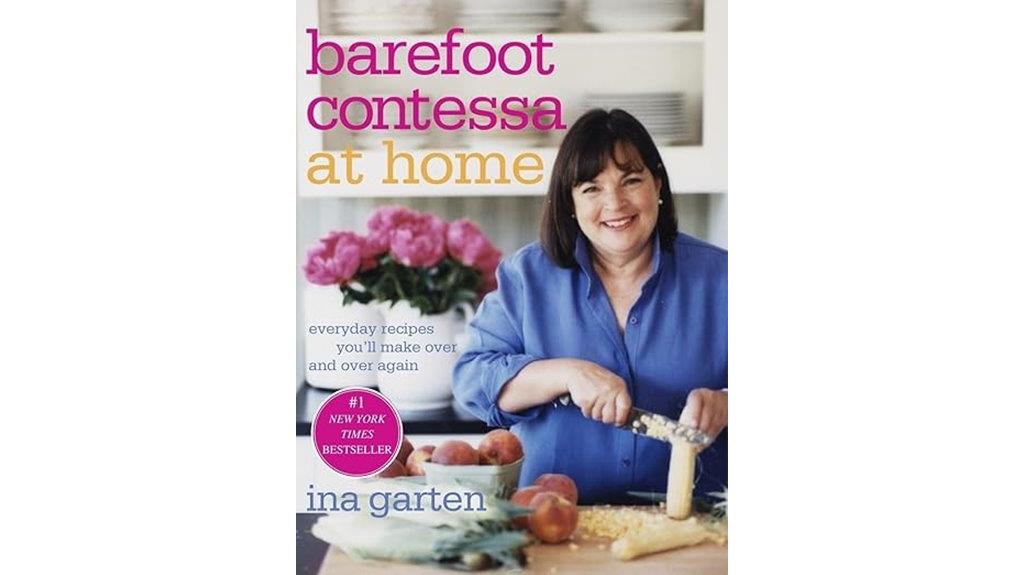
The "Barefoot Contessa at Home" cookbook is perfect for anyone who loves to entertain and wants to create memorable gatherings with ease. Ina Garten's approachable recipes span categories like soups, salads, and desserts, ensuring you find something for every occasion. I've tested fantastic dishes like the Shrimp Bisque and Blue Cheese Burgers, and they've always impressed my guests. The glossy photography and helpful hints make cooking feel accessible. Plus, Ina's casual style inspires me to enjoy the process. With practical tips on ingredients and tools, this cookbook is truly a must-have for creating delightful meals at home.
Best For: Those who love entertaining and want to create memorable meals with simple, approachable recipes.
Pros:
- Easy-to-follow recipes that yield impressive results.
- Beautiful glossy photography and helpful hints enhance the cooking experience.
- Practical tips on ingredients and kitchen tools make cooking more accessible.
Cons:
- Some recipes may require specific ingredients that might not be readily available.
- A limited focus on advanced cooking techniques may not satisfy experienced chefs.
- The casual style may not appeal to those looking for more formal or structured recipes.
Wake Up America: The Nine Virtues That Made Our Nation Great

National Public Gardens Day Events celebrate the beauty and importance of green spaces, making them a perfect choice for anyone seeking to reconnect with nature and community. In Eric Bolling's "Wake Up America," he highlights nine virtues—grit, profit, manliness, thrift, individuality, dominion, merit, pride, and providence—that shaped our nation. He critiques modern society's decline, emphasizing the need to reclaim these values to secure our future. Reflecting on my own journey, I find these virtues resonate deeply. They remind us of the strength and resilience necessary to thrive. Let's embrace these principles and nurture the greatness that defines America.
Best For: Individuals seeking to understand and reclaim the foundational virtues that have historically contributed to America's success and greatness.
Pros:
- Engaging Writing Style: Eric Bolling's narrative connects personal anecdotes with broader societal issues, making the book relatable and thought-provoking.
- Clear Call to Action: The book inspires readers to reflect on and embrace essential American values, fostering a sense of responsibility and accountability.
- Historical Context: Each virtue is supported by historical examples that illustrate their significance in shaping the nation.
Cons:
- Controversial Views: Some readers may find Bolling's critiques of modern society and the radical left polarizing or extreme.
- Lack of Nuance: The book may oversimplify complex societal issues, potentially alienating those who seek a more balanced perspective.
- Target Audience Limitations: The focus on traditional values may not resonate with younger or more progressive audiences who hold different viewpoints.
Im A Seed (Rise and Shine)
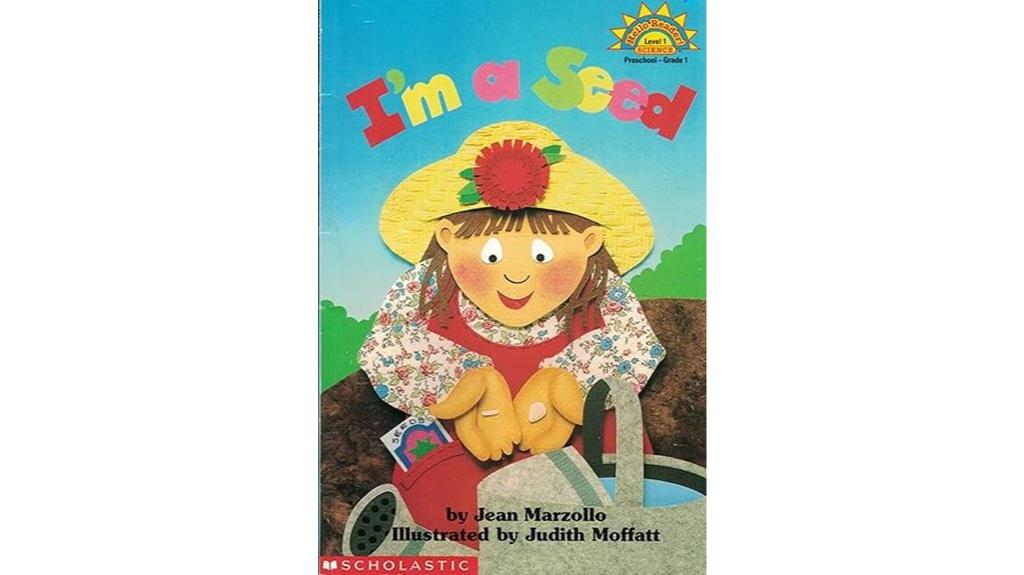
As a parent or educator looking to spark curiosity in young minds, "I'm A Seed (Rise and Shine)" is an ideal choice for National Public Gardens Day Events. This delightful children's book introduces four-year-olds to the life cycle of plants, focusing on pumpkin seeds. Its engaging narrative, featuring a conversation between two seeds, makes reading fun and accessible. The cute fabric collage illustrations capture kids' attention, enhancing their learning experience. Plus, the bilingual elements add a unique cultural twist, making it a great tool for classroom projects. It's a perfect way to celebrate nature and inspire a love for plants!
Best For: "I'm A Seed (Rise and Shine)" is best for parents and educators of four-year-olds who want to introduce young children to the life cycle of plants in an engaging and fun way.
Pros:
- Engaging narrative with a conversational format that makes reading enjoyable for young children.
- Visually appealing fabric collage illustrations that capture kids' attention and enhance learning.
- Incorporates bilingual elements, introducing cultural diversity and additional plant knowledge.
Cons:
- Limited content may not provide in-depth information for older children or advanced learners.
- The focus on pumpkin seeds may not cover a wider variety of plants, limiting exploration.
- The simplicity of the text might not be challenging enough for children who are more advanced in their reading skills.
The Blue Willow Inn Bible of Southern Cooking

For anyone passionate about Southern cuisine, "The Blue Willow Inn Bible of Southern Cooking" stands out as an essential resource. This cookbook features 450 cherished recipes that blend traditional comfort food with innovative dishes. I love how it evokes nostalgia, allowing me to recreate beloved family favorites like Ham and Cheese Pie. The clear writing makes it accessible for both seasoned cooks and novices, which is why it's perfect as a gift. With historical anecdotes that enrich each recipe, this cookbook not only feeds the stomach but also the soul. It's truly a must-have for anyone who appreciates Southern food.
Best For: Anyone who loves Southern cuisine, from seasoned cooks to novices looking to explore traditional and innovative recipes.
Pros:
- Clear and accessible writing, making it easy to follow for all skill levels.
- Includes historical anecdotes that enrich the cooking experience and deepen understanding of Southern culinary heritage.
- Cherished recipes evoke nostalgia, perfect for recreating beloved family favorites.
Cons:
- Some recipes may require ingredients that are not readily available in all regions.
- The cookbook may not cater to those looking for modern dietary restrictions or alternative cooking styles.
- Limited focus on non-Southern recipes may not appeal to a broader audience seeking diverse cuisines.
Big Red Apple (Hello Reader, Level 1)
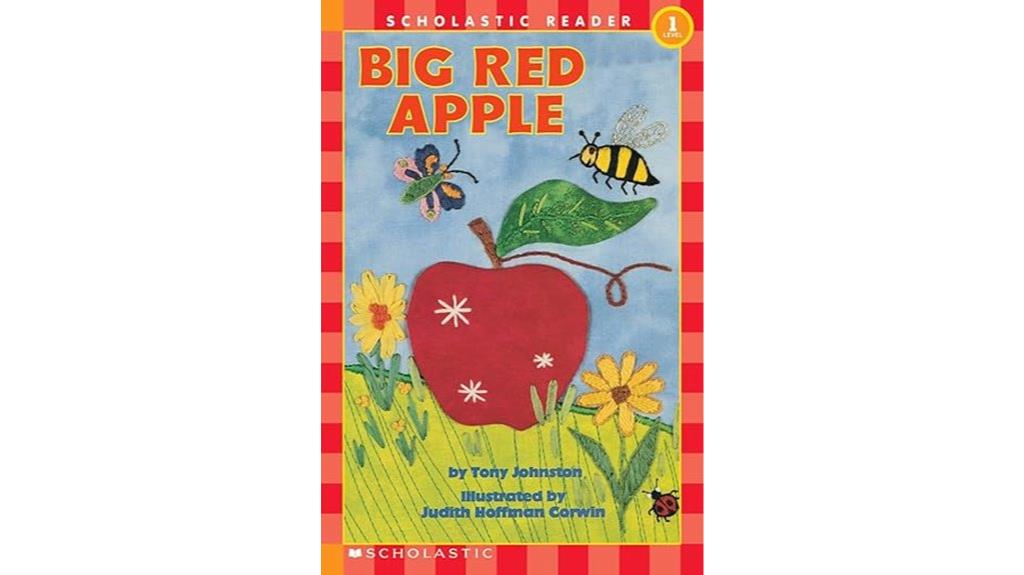
Looking for a delightful way to engage young readers? "Big Red Apple (Hello Reader, Level 1)" is perfect for little ones, thanks to its short length and enchanting illustrations. However, I must admit my disappointment with this particular copy. It had tape on the outside, original library tags, and a pocket, which made it feel less special. Plus, three pages were hanging by tape, and there were scribbles from previous young hands. I initially intended to gift it, but its condition just isn't gift-worthy. Instead, I'll be on the lookout for a nicer book to replace it.
Best For: Young children who enjoy engaging stories with vibrant illustrations.
Pros:
- Short length makes it easy for young children to stay engaged.
- Enchanting illustrations that capture a child's imagination.
- Simple language ideal for early readers.
Cons:
- This particular copy is in poor condition, with tape and library tags.
- Previous ownership marks, including scribbles, detract from the book's appeal.
- Not suitable for gifting due to its damaged state.
How to Become a Gardener: Creating Your Own Food Security
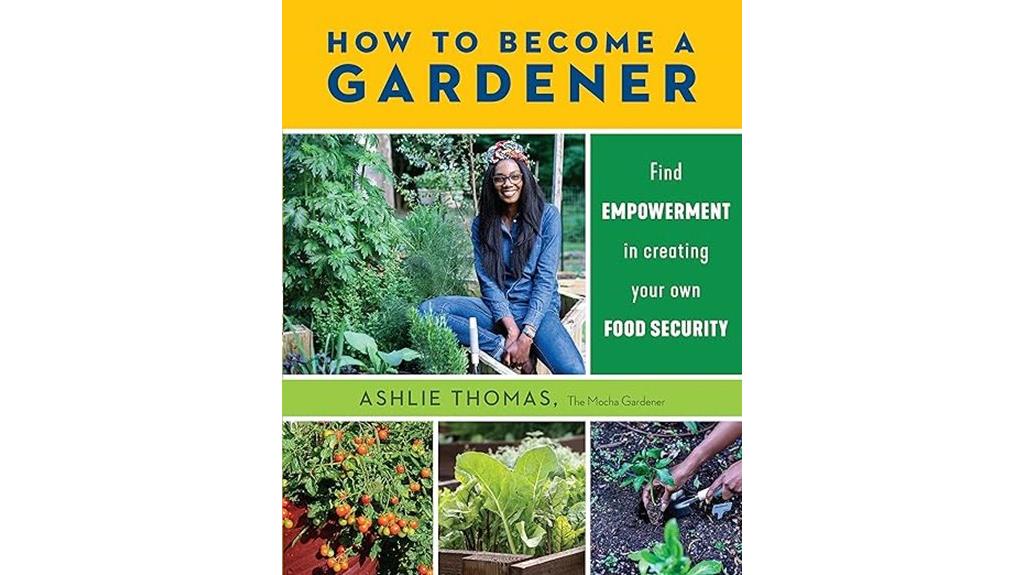
National Public Gardens Day Events are perfect for aspiring gardeners enthusiastic to cultivate their own food security. I found "How to Become a Gardener" to be an empowering guide, focusing on personal growth and community connection through gardening. It's not just about planting; it's about reclaiming our food authority. The book offers practical tips, essential tools, and a variety of vegetables, making it accessible for beginners like me. I've learned to visualize my gardening motivations and embrace challenges. Sharing this journey with others not only enhances our well-being but fosters a deeper connection to our food sources and health.
Best For: Aspiring gardeners seeking to cultivate their own food security and connect with their community through gardening.
Pros:
- Empowering Content: Encourages personal growth and addresses food security, making gardening a meaningful pursuit.
- Beginner-Friendly: Provides practical guidance, essential tools, and relatable tips, making it accessible for those new to gardening.
- Community Focus: Promotes sharing knowledge and building connections, enhancing overall well-being through collective gardening efforts.
Cons:
- Limited Advanced Techniques: May not cater to experienced gardeners looking for advanced strategies or specialized gardening techniques.
- Cultural Representation Focus: While it highlights diverse gardeners, some readers may feel underrepresented if their specific cultural practices aren't included.
- Emphasis on Food Sovereignty: Those less interested in food security may find the focus on reclaiming food authority less relevant to their gardening goals.
Heritage Skills for Contemporary Life: Seasons at the Parris House

Celebrating the connection between nature and heritage, "Heritage Skills for Contemporary Life: Seasons at the Parris House" is perfect for anyone enthusiastic to embrace traditional practices while enjoying the beauty of public gardens. Authored by Beth Miller, the book inspires me to explore hands-on activities like crafting, cooking, and gardening. Organized by seasons, it offers clear projects and recipes, all beautifully illustrated. Beth's conversational writing style makes learning these heritage skills feel accessible and engaging. I find it an invaluable reference for anyone seeking a more connected lifestyle, blending history with practical knowledge right from her charming Maine homestead.
Best For: Anyone looking to embrace traditional practices and heritage skills while enhancing their connection to nature and cultivating a slower lifestyle.
Pros:
- Beautifully organized by seasons, making it easy to find relevant projects and recipes.
- Engaging, conversational writing style that makes learning enjoyable and accessible.
- Visually stunning with high-quality photographs that enhance the overall reading experience.
Cons:
- May not appeal to those uninterested in hands-on activities or traditional practices.
- Some projects may require specific tools or materials that could be difficult to source.
- The focus on heritage skills might not align with modern, fast-paced lifestyles or preferences.
Its Even Worse Than You Think: What the Trump Administration Is Doing to America

If you're someone who appreciates the beauty of nature and the importance of green spaces in urban environments, then National Public Gardens Day Events are perfect for you. However, it's disheartening to see how the Trump administration's policies threaten our environment and communities. David Cay Johnston's book reveals the alarming rollback of essential regulations, impacting everything from clean air to education. With broken promises on infrastructure and immigration, it's clear that the administration's priorities often contradict the well-being of Americans. As we celebrate our public gardens, let's reflect on the urgent need for political change to protect these cherished spaces for future generations.
Best For: Individuals seeking a comprehensive, fact-based analysis of the Trump administration's policies and their impact on America.
Pros:
- Well-researched: The book is grounded in extensive facts and historical context, making it a reliable source.
- Comprehensive coverage: It addresses a wide range of critical issues, from environmental policies to education reforms.
- Encourages reflection: The author's insights invite readers to reconsider their views on Trump's administration and its effects on democracy.
Cons:
- Depressing content: Some readers may find the book's revelations about the administration's actions disheartening.
- Limited personal focus: The book mainly concentrates on policies rather than personal anecdotes or Trump's character.
- Potential bias: Readers looking for a more neutral perspective may view Johnston's criticisms as one-sided.
Factors to Consider When Choosing National Public Gardens Day
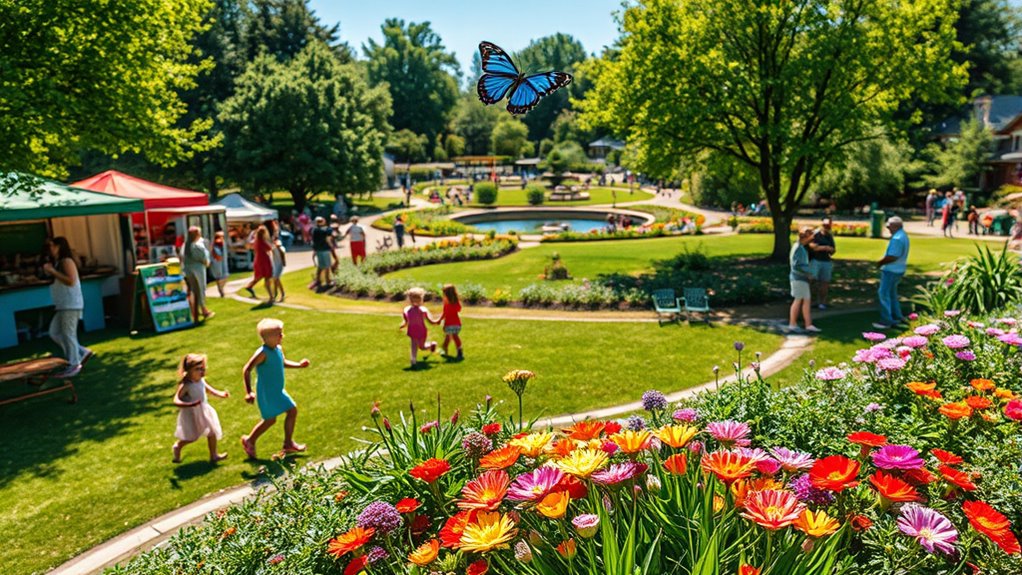
When I'm picking a garden to visit on National Public Gardens Day, I consider a few key factors. I think about how accessible the location is, the variety of gardens and themes they offer, and any special events or educational programs happening that day. Plus, I always check the admission fees and any available discounts to make the most of my experience.
Location Accessibility and Travel
Choosing the right location for National Public Gardens Day involves careful consideration of several travel factors. First off, I always check how close the garden is to major transportation routes; easier travel makes for a more enjoyable day. I also look into accessibility features, like wheelchair ramps and designated parking, to guarantee everyone can comfortably join in. If I'm visiting an urban garden, I consider public transportation options to avoid parking hassles. I make certain to note the garden's opening hours and any special events that might be happening that day. Finally, I research nearby accommodations, dining options, and other attractions, as these can really enhance my overall experience at the garden.
Garden Diversity and Themes
While exploring options for National Public Gardens Day, I find that garden diversity and themes play a crucial role in shaping my experience. The variety of gardens across the country highlights important themes like native plants, sustainable practices, and historical significance. I love visiting specialized collections, from butterfly gardens to herb gardens, each designed to educate me on unique ecosystems. Themed events often feature seasonal blooms, workshops, and community activities that promote biodiversity and conservation. Participating gardens offer guided tours, interactive displays, and expert talks on topics like permaculture and urban gardening. By celebrating these diverse themes, National Public Gardens Day enhances my appreciation for plant diversity and underscores the importance of gardens in fostering community well-being and environmental health.
Seasonal Events and Activities
Experiencing the diverse themes of public gardens naturally leads me to contemplate the seasonal events and activities that make National Public Gardens Day so special. Celebrated on the first Saturday in May, this day coincides with the vibrant blooming season, offering stunning scenery. Many gardens host special events like guided tours and children's activities, creating engaging experiences for families. I love exploring plant sales, where I can purchase native plants and gardening supplies to enhance my own garden. Themed displays and exhibitions showcase seasonal blooms, sparking my interest in various horticultural practices. Community involvement shines through as gardens collaborate with local organizations to promote sustainability and environmental stewardship. These activities truly enrich the experience of National Public Gardens Day.
Educational Programs and Workshops
Many people find that educational programs and workshops during National Public Gardens Day add immense value to their experience. I love how these events engage visitors of all ages, promoting gardening and environmental stewardship. Many gardens offer hands-on workshops where I've learned practical skills like seed starting and organic gardening techniques, which I can apply in my own garden. I also appreciate the guided tours and lectures led by experts in botany and ecology, providing insights into plant care and garden management. Specialized workshops on native plants and sustainable practices deepen my understanding of biodiversity. Plus, the interactive children's programs are fantastic, sparking a love for nature in young visitors. It's a wonderful way to connect with the community!
Admission Fees and Discounts
As I plan my visit for National Public Gardens Day, I always consider admission fees and discounts that can enhance my experience. Many public gardens offer free admission on this day, which is a fantastic way to encourage everyone to appreciate horticulture. I also look for discounted admission rates for families, seniors, and students—these make visits more accessible for diverse audiences. Occasionally, I find promotions like "buy one, get one free" tickets or reduced rates for group visits, which are perfect for exploring with friends or family. Plus, some gardens partner with local businesses to provide additional incentives. To get the best deals, I always check individual garden websites or reach out directly for specific admission fees and special offers.
Family-Friendly Facilities Available
When planning a family outing for National Public Gardens Day, considering family-friendly facilities can make all the difference. Many public gardens offer interactive children's areas, like play zones and hands-on gardening activities, which engage young visitors and spark their curiosity about nature. You'll also appreciate amenities like restrooms with changing tables, picnic spots for family meals, and accessible paths for strollers and wheelchairs. Seasonal events and workshops designed for families make learning about gardening fun and enjoyable. Plus, guided tours tailored for families provide educational content that's suitable for kids, ensuring everyone has a great time. Don't forget about on-site cafes or snack bars with kid-friendly options to keep everyone fueled for the day!
Volunteer Opportunities and Engagement
While exploring the vibrant world of public gardens on National Public Gardens Day, consider diving into volunteer opportunities that truly enrich your experience. Many gardens offer organized programs where you can engage in gardening, maintenance, and educational activities. I've found that hands-on experiences like planting, weeding, and harvesting not only boost my skills in horticulture but also connect me to local biodiversity. Participating in these programs enhances community involvement and fosters a sense of stewardship for our green spaces. Some gardens even host special volunteer days, allowing us to learn about sustainable practices while meeting fellow gardening enthusiasts. Plus, the training sessions and workshops offered deepen our understanding of local ecosystems, making the experience even more rewarding.
Conservation Efforts and Initiatives
Engaging in volunteer opportunities at public gardens not only deepens our connection to the community but also highlights the fundamental conservation efforts taking place. National Public Gardens Day emphasizes the important role these gardens play in preserving biodiversity. Many gardens actively protect endangered plant species, restore native habitats, and promote sustainable gardening practices.
Through hands-on research and community engagement, they provide resources on cultivating native plants, making a tangible impact on our ecosystems. Educational programs teach us the ecological value of plants and how to support local environments. Additionally, collaborative efforts among gardens raise awareness and funding for these initiatives, ensuring that valuable plant species and habitats are preserved for future generations. Let's celebrate and support these significant conservation initiatives together!
Frequently Asked Questions
What Activities Are Typically Held During National Public Gardens Day Events?
During National Public Gardens Day events, you'll often find a variety of activities that celebrate nature and gardening. I love participating in guided tours that showcase beautiful plants. There are usually educational workshops too, where I learn about sustainable practices. You'll often see family-friendly activities, like scavenger hunts or craft stations for kids. Live music and food vendors create a festive atmosphere, making it a perfect day to connect with nature and fellow garden enthusiasts.
How Can I Participate in My Local Garden's Celebrations?
I love getting involved in my local garden's celebrations! To participate, I check their website or social media for event details. I often volunteer for activities like planting, guided tours, or educational workshops. I also invite friends and family to join me for a fun day outdoors. Sometimes, I even bring snacks to share. It's a great way to connect with nature and meet others who share my passion for gardening!
Are There Any Costs Associated With Attending These Events?
I've found that costs can vary considerably when attending local garden events. Some places offer free admission, while others might charge a small fee for entry or special activities. It's best to check the specific garden's website or social media for details. I usually budget a little extra just in case there are workshops or food vendors. Participating is worth it, and I love supporting my community while enjoying nature!
What Age Groups Are National Public Gardens Day Events Suitable For?
When I think about the joy of a child exploring blooms versus an elderly person reminiscing among the petals, it strikes me how age really doesn't matter in these moments. National Public Gardens Day events are perfect for everyone—families with kids, teens, adults, and seniors alike. Each age group finds something special in the beauty of gardens, whether it's learning, relaxing, or connecting with nature. It's a day for all of us to enjoy together.
How Can I Find a List of Participating Gardens Near Me?
To find a list of participating gardens near you, I usually start by checking the official National Public Gardens Day website. They often provide an interactive map or a directory of gardens that are taking part. I also look at local gardening clubs or community websites, as they sometimes share information about events. Social media can be helpful too; I follow local garden pages for updates and announcements. Happy exploring!
Conclusion
As we celebrate National Public Gardens Day, it's fascinating to note that over 75 million Americans visit botanical gardens each year! These spaces not only showcase stunning flora but also foster community connections and promote environmental awareness. So, whether you're a seasoned gardener or just a nature enthusiast, I encourage you to explore your local garden events. You'll find beauty, inspiration, and a chance to connect with others who share your love for nature. Enjoy the day!
